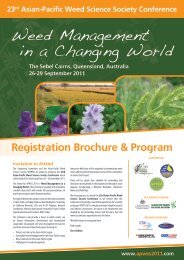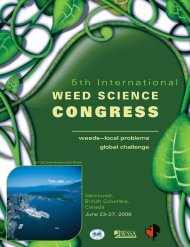PARAQUAT
PARAQUAT
PARAQUAT
You also want an ePaper? Increase the reach of your titles
YUMPU automatically turns print PDFs into web optimized ePapers that Google loves.
4.2 Terrestrial toxicity<br />
Paraquat is moderately toxic to mammals and<br />
birds (US EPA 2009).<br />
The European Commission‘s Scientifi c<br />
Committee on Plants expressed concern in 2002<br />
about the effects of paraquat on wildlife welfare,<br />
especially on hares and birds. They concluded<br />
that it “can be expected to cause lethal and<br />
sublethal effects and this is confi rmed by fi eld<br />
reports” (EC 2002).<br />
Mammals<br />
Acute toxicity – LD 50 (US EPA 1997):<br />
• male rat = 334 mg/kg bw<br />
• female rat = 283 mg/kg bw<br />
• rabbit = 110 mg/kg bw<br />
• Belgian hare = 35 mg/kg bw<br />
Based on toxicity to rodents, US EPA (1997)<br />
concluded that paraquat is moderately acutely<br />
toxic to small mammals, and lethal below<br />
25 ppm after 12 weeks exposure. Freshly<br />
sprayed foliage can induce death in rabbits, and<br />
especially the hare.<br />
Birds<br />
Paraquat is generally less toxic to birds than it is<br />
to mammals. Nevertheless exposure, especially<br />
chronic exposure, remains a risk and especially<br />
to reproduction. Eisler (1990) reported that some<br />
birds are very much more sensitive than others,<br />
with adverse effects at 10 mg/kg bw in nestlings of<br />
the American kestrel (Falco sparverius) causing<br />
reduced growth; 20 mg/kg in the diet of northern<br />
bobwhite (Colinus virginanus) causing reduced<br />
egg deposition; and 40 mg/L in the drinking water<br />
of domestic chickens (Gallus sp.) increasing the<br />
number of abnormal eggs produced. The lowest<br />
doses of paraquat causing measurable adverse<br />
effects in sensitive species of birds were 0.2<br />
mg/kg bw administered by single intravenous<br />
injection to Japanese quail, causing anemia; and<br />
0.25 mg/kg applied in oil solution to the surface<br />
of mallard eggs, producing reduced survival,<br />
reduced growth, and increased frequency of<br />
developmental abnormalities (Eisler 1990).<br />
These are considerably lower values than LD 50 s<br />
reported by FAO.<br />
Acute toxicity – LD 50 (96 hr):<br />
• unspecified = 35 mg/kg (EC 2003)<br />
• Bobwhite quail = 127 mg/kg bw (FAO 2008)<br />
• Mallard duck = 144 mg/kg bw (FAO 2008)<br />
Acute toxicity – NOEL:<br />
• Bobwhite quail = 72 mg/kg bw (FAO 2008)<br />
Dietary toxicity – LC 50 (FAO 2008):<br />
• Bobwhite quail = 711 mg/kg diet<br />
• Mallard duck = 2,932 mg/kg diet<br />
• Japanese quail = 703 mg/kg diet<br />
Reproductive toxicity – NOEC<br />
• Unspecifi ed = 30 mg/kg diet (EC 2003)<br />
• Bobwhite quail = 100 mg/kg (FAO 2008)<br />
• Mallard duck = 30 mg/kg (FAO 2008)<br />
Signs of oral paraquat intoxication in birds<br />
include excessive drinking and regurgitation,<br />
usually within 10 min of exposure. Other signs<br />
appearing after 3 hours include diarrhoea,<br />
ruffled feathers, lack of coordination, imbalance,<br />
wing drop, slowness, weakness, running and<br />
falling, constriction of pupils, and terminal<br />
convulsions. Additional signs reported after<br />
dermal exposure include blistering and cracking<br />
of skin, lacrimation, wingspread, and wing<br />
shivers. Death usually occurred between 3 and<br />
20 hours (Eisler 1990).<br />
The US EPA (1997) concluded that paraquat is<br />
moderately toxic to birds on both an acute and<br />
sub-acute dietary basis; and that it can affect<br />
reproduction or hatchability of eggs when adult<br />
birds are exposed.<br />
The European Commission‘s Scientifi c<br />
Committee on Plants stated that “the possible<br />
effects on the reproduction from spray solutions<br />
reaching eggs in nests and resulting in reduced<br />
hatching and abnormalities could be of serious<br />
concern” (EC 2002).<br />
At concentrations less than the recommended<br />
application rate, paraquat is embryotoxic to<br />
developing eggs of migratory waterfowl (0.056<br />
kg/ha) (Eisler 1990).<br />
Paraquat has caused pseudofeminization of<br />
male chicken and quail embryos; testes showed<br />
intersexual phenomena and Mullerian duct<br />
abnormalities; both sexes had a reduction in the<br />
number of gonocytes (germ cells responsible<br />
for spermatogenesis in males, and oogenesis in<br />
31




